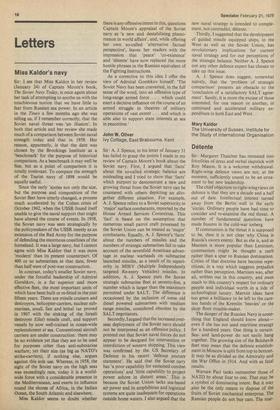Miss Kaldor's navy
Sir: I see that Miss Kaldor in her review (January 24) of Captain Moore's book, The Soviet Navy Today, is once again about her task of attempting to soothe us with the mischievous notion that we have little to fear from Russian sea power. In an article in the Times a few months ago she was telling us, if I remember correctly, that the Soviet naval threat was 'an illusion'. In both that article and her review she made much of a comparison between Soviet naval strength today and that in 1958. Her reason, apparently, is that the date was chosen by the Brookings Institute as a 'benchmark' for the purpose of historical comparison. As a benchmark it may well be fine, but as a point of comparison it is totally irrelevant. To compare the strength of the Tsarist navy of 1898 would be equally useful.
Since the early 'sixties not only the size, but the purpose and composition of the Soviet fleet have utterly changed, a process much accelerated by the Cuban crisis of October 1962, when the USSR found itself unable to give the naval support that might have altered the course of events. In 1958, the Soviet navy was seen strategically by the policymakers of the USSR merely as an extension of the Red Army for the purpose of defending the enormous coastlines of the homeland. It was a large navy, but I cannot agree with Miss Kaldor that it was more 'modern' than its present counterpart. Of 400 or so submarines at that date, fewer than half were of post-war construction.
In contrast, today's smaller Soviet navy, under the forceful leadership of Admiral Gorshkov, is a far superior and more effective fleet, the most important units of which have been built or re-fitted in the past fifteen years. There are missile cruisers and destroyers, helicopter-carriers, nuclear submarines, small, fast and lethal (as proved in 1967 with the sinking of the Israeli destroyer Eilat) missile craft, and support vessels by now well-trained in ocean-wide replenishment at sea. Conventional aircraft carriers are under construction: there may be no evidence yet that they are to be used for purposes other than anti-submarine warfare; yet their size (as big as NATO's strike-carriers), if nothing else, argues against this sole use. Whereas, in 1958, the sight of the Soviet navy on the high seas was exceedingly rare, today it is a worldwide force with a considerable presence in the Mediterranean, and exerts its influence round the shores of Africa, in the Indian Ocean, the South Atlantic and elsewhere.
Miss Kaldor seems to doubt whether there is any offensive intent in this, questions Captain Moore's appraisal of the Soviet navy as 'a new and destabilising phenomenon in world affairs', and, while offering her own so-called 'alternative factual perspective', leaves her readers with the impression that 'peace' co-existence' and 'détente' have now replaced the more hostile phrases in the Russian equivalent of the Fighting Instructions.
As a corrective to this idea I offer the view of Admiral Gorshkov himself: 'The Soviet Navy has been converted, in the full sense of the word, into an offensive type of long-range armed force . . . which could exert a decisive influence on the course of an armed struggle in theatres of military operations of vast extent . . . and which is able also to support state interests at sea in peacetime.'
John W. Oliver Ivy Cottage, East Brabourne, Kent


































 Previous page
Previous page